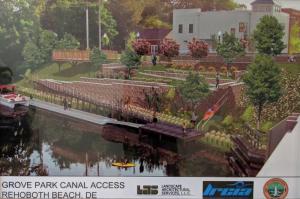While driving toward the beaches with the eager excitement that summer days bring, it’s easy to forget the amount of history that passes by. It’s impossible to make it to the ocean without passing over the Lewes-Rehoboth Canal, and while its story is fascinating, not many know of the waterway’s relevance.
Rehoboth Beach Museum held an exhibit and lecture recently regarding the little-known canal. Staff member Paula Roberts explained her research and findings, coloring the ambitious story of the watercourse.
The canal was authorized by the U.S. River and Harbor Act of 1912 and started construction in 1913. The purpose was to become a public-private partnership. Businesses would be able to ship products along the 10-mile stretch from Rehoboth Bay to Delaware Bay efficiently, but would have to pay to use the waterway, and tolls would be set along the route. The first boat traveled along the canal Oct. 8, 1916.
In 1917, 15,000 tons of supplies were sent along the Lewes-Rehoboth Canal. The traffic allowed for some industry to begin in the surrounding area. Factories for canning oysters and vegetables, a laundry house, and an ice house were opened along the waterfront. The most popular of the canneries started as the Atlantic Cannery in 1910. It began to thrive off the influx of product along the waterway. It eventually became the Stokely Van Camp Cannery until it closed in the 1960s.
Unfortunately, roadways had become wildly popular, and more efficient with the automobiles and trucks, marginalizing the purpose of the water route. The drawbridge crossing the canal began construction in 1924, and its transportation use dwindled. The canal ended up being used for more recreational boating and crabbing than shipping, and by the 1930s, not even 100 tons of supplies were shipped annually.
Eventually, with the decline of shipping and poor management of the canal, the waterway was cast aside. The canneries had been dumping their waste, like potato and tomato skins, into the water. Toward the end of the canneries’ lives in the 1960s, ecologists began to realize that the canal water was bringing nitrates and phosphates into the Rehoboth Bay, which were ultimately killing the surrounding bay grasses. Luckily, the factories had been shutting down, so the waste stopped.
The canal was abandoned as an economical pursuit. Lewes’ end kept up with the maintenance, but the Rehoboth area was cast it aside and regular dredging stopped. Roberts said, “Once the factories closed down, Rehoboth stopped seeing its economic value, so it just kind of sat there.”
Though not many have traveled the canal since the 1920s, things are again looking up for the once-lucrative waterway. The Lewes-Rehoboth Canal Improvement Association has raised up to three-fourths of the funding needed to re-establish a city dock, so the canal can once again be used for transportation and recreation. This improvement could lead to water taxis becoming more prominent, lightening up the traffic on the roadways, and new housing. “The goal is that it can go back to its days of recreational boats… Once the canal comes back to a vital stage, we’ll probably see a lot of creative people make something of it,” Roberts said.
Though the waterway was not as prosperous as originally envisioned due to the rise of automotive transportation, the planned dock and improvements may bring life to the historic and often overlooked canal.
























































